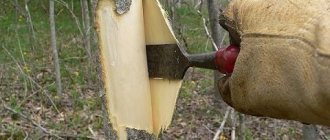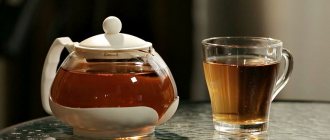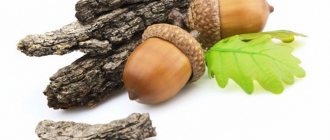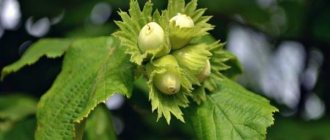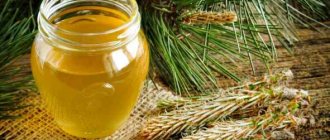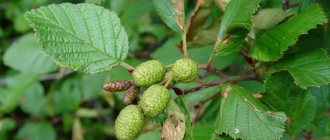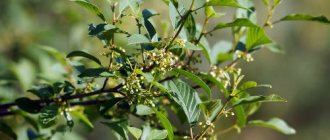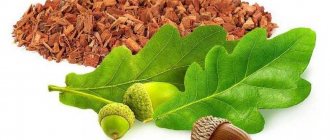Description and chemical composition
The height of a mature tree can reach 30 m, width - 50-100 cm. Life expectancy - up to 150 years. The root system is well developed and deep, which makes the tree stable in strong winds. The bark of a young tree is olive-colored, smooth, while that of an adult tree is dark gray, with small cracks.
The leaves are round in shape with jagged edges, attached with thin petioles. Long and laterally compressed petioles lead to constant vibration of the leaves. That is why the impression of continuous trembling of the crown is created.
Aspen is a dioecious plant. The catkins of the male tree are reddish in color, about 15 cm long, while the female ones are narrower and shorter, greenish in color. The flowering time of the plant is April-May, after 35 days the seeds ripen. The tree reproduces by both seeds and root suckers.
, tree bark is most often used to prepare decoctions and infusions . The beneficial properties of aspen bark are due to the fact that it contains:
- tannins, which have an anti-inflammatory effect on the gastric mucosa, remove heavy metals,
- glycosides with diuretic, laxative, sedative, expectorant and disinfectant effects,
- pectin and lignan - means for reducing cholesterol levels, normalizing metabolism and hormonal levels,
- sterol that strengthens the human cardiac system,
- a whole range of trace elements, including iron, zinc, copper, nickel and molybdenum.
The leaves contain no less useful components:
- a large group of carbohydrates that provide the body with energy, normalize metabolic processes, sugar content,
- vitamins, including ascorbic acid, necessary to increase immunity, improve capillary permeability,
- anthocyanins, which will reduce the fragility of capillaries and blood vessels, relieve inflammation and strengthen the heart muscles.
Aspen buds , the medicinal properties of which are undeniable, are included in a variety of herbal preparations. A tincture made from them will help get rid of many ailments. Aspen buds contain:
- resinous substances that have a bactericidal, wound-healing effect,
- essential oils to improve the functioning of the central nervous system and enhance the secretion of glands.
- wax, which has a bactericidal effect, is used to treat non-healing wounds and skin diseases.
Aspen juice contains almost all of the listed beneficial components, but in lower concentration.
Aspen medicinal properties for prostatitis
aspen is a tall deciduous tree with smooth gray bark of the willow family.
In Ukraine, it is widespread, found in coniferous, deciduous and mixed forests.
The bark of young branches, buds and young leaves are used for medicinal purposes.
The branches are cut off in early spring during the period of sap flow, the buds in the spring, before blossoming begins. The raw materials are dried under a canopy, stored in hermetically sealed containers, in canvas, paper bags, and boxes.
Shelf life - 1 year.
Aspen is used as:
- bactericidal;
- anti-inflammatory;
- antipyretic;
- diaphoretic.
Aspen bark contains a natural analogue of aspirin - salicin. This component fights inflammatory processes, viruses, parasites and bacteria. Aspen actively fights Staphylococcus aureus and Pseudomonas aeruginosa.
Aspen bark for prostatitis:
- naturally reduces swelling and spasm of the prostate gland;
- has an anti-inflammatory effect;
- is a natural diuretic;
- eliminates bladder blockage;
- has an analgesic effect.
Decoctions and infusions of aspen are taken for:
- bronchopulmonary diseases (colds, fever, chronic bronchitis, pneumonia, severe coughing attacks);
- diseases of the liver and biliary tract;
- gastrointestinal diseases (gastritis, diarrhea, hemorrhoids);
- diseases of the genitourinary sphere and kidneys (nephritis, urethritis, cystitis);
- problems of the oral cavity (sore throat, gingivitis, inflammation of the oral mucosa, toothache);
- diseases of the musculoskeletal system (polyarthritis, gout, rheumatism).
The ointment is a fatty extract from the kidneys and is used externally as an analgesic and wound-healing agent for festering wounds, chronic ulcers, burns, eczema, for the resorption of hemorrhoids, as well as for rubbing joints and muscles.
Preparation and recipes:
Bark decoction: 1 tbsp. spoon of raw material in 1 glass of water, boil for 3 minutes, leave for 1 hour, strain before use, take 0.25 glass 3 times a day 30 minutes before meals.
- Infusion of bark: 1 tbsp. spoon of raw material per 1 cup of boiling water, leave for 2 hours, strain before use, take 0.25 cup 3 times a day before meals.
- Bud tincture: infuse 1 tbsp. a spoonful of raw materials in 40% alcohol (1:10) for 7 days in a warm place, strain before use, take 30 drops 3 times a day before meals.
- Ointment: infuse raw buds in olive oil (1:5) or grind the dried ones into powder, mix with butter (1:1) and leave for 2 weeks in a warm place, lubricate the affected areas.
Contraindications: pregnancy and lactation; individual intolerance.
Useful properties of aspen
Due to its unique composition, this plant has been used since ancient times to treat many diseases. Decoctions, ointments, tinctures, compresses are popular to this day.
- Tincture of buds with alcohol and water infusion of buds, due to their antimicrobial properties, are used as a diaphoretic or anti-inflammatory during colds.
- The astringent effect of aspen decoction will help with gastritis and diarrhea.
- Ointment made from tree ash has an analgesic and antiseptic effect, so it is actively used for any damage to the skin: burns, boils, eczema.
- Young shoots, leaves and buds are used as a hemostatic and wound healing agent for cuts.
- Men are recommended to take it for disorders of the genitourinary system: prostatitis, prostate adenoma, decreased potency.
- Antimicrobial and anti-inflammatory properties make the raw material attractive for the treatment of rheumatism, tuberculosis, malaria, dysentery, pneumonia, and coughs of various origins.
- Improving metabolic processes, lowering glucose levels and stimulating the functioning of the pancreas will significantly improve the condition of a patient with diabetes.
- Using a decoction of aspen, you can get rid of opisthorchid - worms that parasitize the liver. The drug successfully destroys adult parasites, their eggs and larvae.
- Aspen bark, endowed with anti-inflammatory properties, will help in a short period of time cope with both a sore throat and any other inflammatory diseases of the mouth and throat.
- Glue is collected from the blossoming buds of the tree, which is later processed into propolis.
Aspen bark - beneficial properties and contraindications
The beneficial properties of aspen were well known to our ancestors, who used it to treat various ailments. Aspen belongs to the willow family. It is distributed over a large territory of our homeland and grows in forest-steppe and forest zones.
Useful properties of aspen
Aspen bark, its young shoots, buds and leaves are used for medicinal purposes . All of them have astringent and hemostatic properties.
Aspen bark is considered the most valuable in folk medicine. It contains semilin, salicin and tannins, and in large quantities. Research has shown that the bark contains a substance whose composition is a natural substitute for aspirin.
Aspen bark, application
Aspen bark as a medicine is used in traditional medicine to treat various diseases of the bladder: urinary incontinence, cystitis and others. It also helps with disorders of the stomach and intestines, hemorrhoids and prostate hypertrophy. It can effectively relieve cough, increase appetite and reduce fever.
Aspen bark, which can be used in decoctions and infusions, helps with disorders of the human nervous system and diabetes. To do this, carefully crushed bark in the amount of one glass is poured with three glasses of boiling water and boiled for half an hour, and then wrapped and left for about six hours. The finished broth is taken 3 tablespoons 30 minutes before meals. For the treatment of complex diseases, such as joint damage and diabetes, the process of taking the drug can be long - up to two months. After this, you need to take a break for one month and only after that the course can be repeated.
The bark is also used to treat various colds. To obtain a more complete and stronger effect, aspen leaves and buds are added to preparations based on the bark of the plant. This set of beneficial substances effectively reduces temperature and cures many problems of the respiratory system: pneumonia, bronchitis, cough, sore throat.
Aspen buds, or rather an alcohol tincture based on them, have a strong bactericidal effect that can destroy such a storm as Staphylococcus aureus. Infusions and infusions are prepared from aspen buds, which are excellent for rheumatism, gout and various infections.
On the subject of using medicines from aspen, traditional medicine can give several worthwhile recommendations:
After a large loss of blood, combining aspen bark with other parts helps to recover very quickly.
If there are problems with the skin, aspen bark is used. Preparations based on it can cope with boils, burns, eczema and other lesions. To treat skin diseases, an alcohol tincture of aspen leaves, bark and buds is used. And you can use any baby cream as the basis for this remedy.
Older men are strongly recommended to take a decoction of aspen bark. This allows for effective and efficient prevention of prostatitis. To obtain a stronger effect, use the bark of a young plant.
It is best to collect the bark from April to May, at which time the sap begins to flow. To collect medicinal raw materials, young plants are chosen, those whose bark is no thicker than seven millimeters. Care should be taken when removing the bark. To do this, use a sharp knife to make a cut around the trunk. The next incision is made at a distance of about ten centimeters. Vertical cuts are made in the resulting cylinder and the bark is carefully removed from the tree. Be careful not to snag the wood. The collected raw materials can be dried in the oven.
You can make your own tincture from the resulting dry aspen bark. To do this, about 200 grams of raw materials are poured into a jar and filled with a bottle of vodka. The tightly closed jar is placed in a dark place for two weeks. The resulting medicine is taken as follows: for 15 grams of vodka, take 20 drops of tincture and this entire mixture is consumed half an hour before meals, three times a day. The medicine should be taken daily and at a strictly prescribed time. The course of treatment lasts about 3 months, the most important thing is that there are no missed appointments. This medicine is considered very effective. As it progresses, the body will renew itself and get rid of a large number of ailments.
Aspen bark contraindications
Aspen bark, the contraindications of which are completely insignificant, is still a medicine, so you should consult a doctor before use . Since the bark of this tree contains a lot of tannins, in some cases their astringent property can lead to constipation. And if you already suffer from this disease, then you should be especially careful. Cases of individual intolerance are also possible.
Recipes for preparing medicines based on aspen
- To prepare a medicine for mastopathy , place 500-600 g of dried bark in a metal bowl or pan, add 2 liters of water and cook over low heat for 2 hours. Then the mixture is allowed to cool and passed through a filter. Add 0.5 liters of vodka (or alcohol) to the finished broth. The medicine is divided equally into 20 servings and taken one serving per day 30-40 minutes before meals.
- For treatment opisthorchiasis It is enough to prepare a decoction. To do this, pour 50 g of ground bark into 0.5 liters of cold water. Boil for at least 10 minutes. Place the container with the broth, having previously wrapped it, in a warm place for 3 hours. Take 2-3 sips throughout the day (4-5 times).
- Tincture of aspen bark with vodka is no less effective than a decoction, and its use as a general tonic will improve metabolism and strengthen the immune system. Pour 100 g of medicinal raw material into a liter jar, then add 200 ml of vodka. Close the jar tightly and leave in a dark place for 14 days. Take 15-20 drops of the drug before meals. If necessary, a portion of the medicine can be diluted in 0.25 glasses of still mineral water.
- Joint diseases, injured ligaments, sore muscles successfully treated with alcohol infusion from aspen bark. You need 1 tbsp. l. pour dry crushed raw materials with 10 tablespoons of high-quality vodka. The medicine is infused in a dark and warm place for 2 weeks. The composition must be shaken periodically. The finished infusion is filtered and taken 1 teaspoon 3 times a day. The same preparation is also used for rubbing. This must be done in the morning and evening. After rubbing, insulate the affected areas for 1 hour.
- To obtain an ointment for treating wounds, burns and ulcers, you need to prepare pure ash from aspen bark. 10 g of such ash is thoroughly mixed with 50 g of homemade butter or lard. The mixture must be refrigerated overnight. The wound is first treated with a weak solution of manganese, then the ointment is applied in a layer 2-3 mm thick. Cover the top with a clean gauze cloth. Treatment lasts until the wound is completely healed. If it is difficult to find ash, you can try to treat wounds with prickly pear leaves.
- Diseases of the throat and mouth can be cured if 1 tbsp. l. steam crushed aspen with a glass of boiling water and leave in a thermos for about 2 hours. Strain. Rinse your throat and mouth 5 times a day, using 100 ml of the drug per procedure. Used until complete recovery. This drug, along with sedum tincture, is recommended for use in bleeding gums.
- Tincture of aspen bark, due to its medicinal properties, is used for prostatitis, cystitis and prostate adenoma. Pour 500 ml of vodka into 200 g of crushed aspen bark. Close and leave in a dark place at room temperature for 14 days. It is taken diluted (20 drops of the drug per 50 ml of water) once a day for 3 months.
Recipes for treating aspen buds and leaves
The wonderful aspen tree saves you from many ailments. Recipes for treating aspen buds and leaves are very well known all over the world and are often used for various human diseases. When the trigeminal nerve or lower back hurts, aspen dies are used - round, polished sections. And it’s better to take an aspen broom to the bathhouse; its healing power is superior to both birch and oak.
Aspen is a wonderful, magical tree that is used for diarrhea and intestinal disorders only with a bang. The following recipe is used: 1 tbsp. pour aspen bark into a thermos and pour 250 ml of boiling water. Leave for 20 minutes, strain. Take 1/3 cup 3 times a day with warm meals.
Sore joints and swollen bones due to gout are well rubbed with ointment:
take 2-3 tablespoons of aspen buds, grind them, pour in 100 ml of olive oil. Insist for a month. You don't have to strain it. Use aspen ointment as needed. The magic tree will also help with burns, inflammation of hemorrhoids, and wounds.
WE TREAT KIDNEYS
Pyelonephritis does not go away without a trace: you get sick once, and then exacerbations occur. The most effective medicine is a decoction of aspen leaves, twigs and bark. In this case, aspen will also save you here, as it will help you cope with the disease.
For treatment, the following recipe is used: pour 1 glass of water into a mixture of 1 tbsp. twigs, leaves and aspen bark. Boil for 10 minutes, strain. Drink half a glass 3-5 times a day. The course of treatment is 3-4 weeks with a break of 10 days.
This remedy works comprehensively. The decoction helps remove harmful salts from the body and normalizes the functioning of the bladder.
MEN'S MEDICINE
Aspen buds and leaves are a valuable remedy for the prevention of prostatitis and prostate adenoma. The wonderful aspen tree will help and save very well.
It is necessary to prepare an infusion: 2 tbsp. crushed kidneys, pour 1 cup of boiling water, keep on low heat for 10 minutes, leave for 1 hour. Strain and add boiled water to the original volume. Take the infusion 1/3 cup 3 times a day half an hour before meals.
If you simultaneously take bee pollen and bee bread regularly for a long time, you can extend the period of remission to several years.
WHAT IS ASPEN USEFUL FOR?
The bark and leaves of the wonderful aspen tree contain a natural form of aspirin. Therefore, it copes with inflammatory diseases. A lot of recipes for treating aspen buds and leaves can be found in various sources.
A decoction of aspen bark is used for intestinal disorders, cystitis, gout, and diabetes. It will help and cure many ailments, which is not typical for all trees.
Compresses with carefully ground aspen leaves perfectly relieve joint pain.
Aspen buds are of particular value: the alcohol tincture contains bactericidal substances that have a detrimental effect on Staphylococcus aureus and bacteria of the enteric typhoid group.
Aspen is used in official medicine. Preparations from it treat the liver, spleen, kidneys, joints, mucous membrane, and nervous system.
Preparations from the wonderful aspen tree have diaphoretic, antipyretic, anti-inflammatory, astringent and diuretic effects and will save you in many difficult situations.
Contraindications
Aspen bark, which has unique medicinal properties, also has some contraindications.
You should use aspen-based preparations with caution in case of dysbacteriosis.
When treating, it is important to know that aspen has an astringent effect, so it is not suitable for chronic intestinal diseases and constipation. A natural laxative made from dandelion roots will help relieve constipation.
Alcohol tinctures from this plant are not recommended for use:
- with ulcerative-erosive lesions of the mucous membrane of the gastrointestinal tract at the acute stage,
- for neurological disorders,
- pregnant women, nursing mothers and children.


